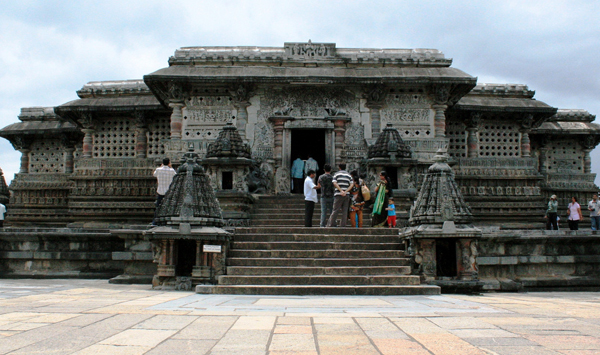Chennakesava Temple

Information of Chennakesava Temple, Belur, Hassan, Karnataka
Chennakesava Temple is an immense ancient Hindu temple of Lord Shiva. It was the great grandeur of Hoysala Dynasty in the 12th century AD. This temple is listed in the UNSECO temple site of India. This temple is functioning as usual with poojas and rituals, even though it is a protected monument. Many tourists come here to see the vast architectural patterns. Many pilgrims come here from south India, in the temple season times. It is beautifully located at Belur Town of Hasan District in Karnataka State of India.
Chennakesava Temple Religious Significance
Chennakesava Temple is the main worship place for the Vaishnaviks. Kesava is the other name of Lord Vishnu and the Chenna means the beautiful. But this temple is also having the deities of Lord Sri Krishna and Sri Lakshmi. All these deities are found in the standing positions. Here the daily poojas are conducted by its temple priest. Special archanas on individual names are also done on request. Apart from Vaishnavik sect, this temple is also visited by the other sects of the Hindu religion.
Festival at Chennakesava Temple
Chennakesava Temple's main festival is the Vaikunta Ekadashi. Thousands of devotees come here for the Vishnu Darshana, since this day is considered to be the day when heaven open its doors for the earthly abode peoples. Many pilgrims take part in the special poojas performed here for Vishnu Bhagavan and get blessing from this Lord for a heavenly abode in future.
Chennakesava Temple Mythology & History
Chennakesava Temple was built by the Hoysala king named Vishnuvardhana. There are many stories told on this behalf. The temple does have inscriptions mention these events. It is said that the King was a Jain and he converted to Hinduism by accepting the Vishnavik Sect. That's why he built this temple to Lord Vishnu in his capital town. Another story is written here stating this temple's name as the Vijayanagara Temple. Since this was constructed here to mark the victory of King Vishnuvardhana over the Chalukayans of his western region and the Chollas of the southern region.
Chennakesava Temple Architectural Significance
Chennakesava Temple is a mix of the Hoysala and the Dravidian architectural pattern. This temple is constructed with soap stones. The gopura (minaret) are found in the Dravidian style. The main entrance itself is having a huge gopura and a garuda sthamba (pole). This gopura itself shows the craftsmanship of that period. There are beautiful motifs and miniature carvings on this gopura. There are also small gopuras built on the other minor temples built here. The Hoysala style is dominant in the rest of the structures apart from its gopuras. These are having much remarkable craftsmanship. The entire structure is standing on a raised stone platform. This temple is seen with multi square complexes in the same platform and is very different to see when compared to other Hindu temple found in India. This temple is fenced from all four sides and the importance of this stone fenced walls are having mandapas (Hall) in the inner side of this walls. These are supported with uniquely carved small pillars. This mandaps runs on all side of this temple and looks great from inside. The entire structure is filled with motifs, miniatures and big sculptures. There are many tiered pillars seen on the edges of this temple, which are really looking great. Inside this temple the pillars are found in the round shape having many designs on it. Its ceiling is really breath taking to look. There are many domical bay carving on these stone roofs. There are many Hindu mythical depiction on the stones found here in the miniature forms. There are also many life size sculptures found inside this temple. The main idols are carved out of single stone and are very beautiful to look. There are also other minor temples found on the same temple complexes built for its sub deities. A temple pond is found here with in the temple premises. This temple also got a wooden chariot with a golden horse statue attached with it. The garbhagraha (sanctum sanctorum) are found with many designs with lintel entrance.
- Andhra Pradesh Temples
- Assam Temples
- Bihar Temples
- New Delhi Temples
- Goa Temples
- Gujarat Temples
- Jammu and Kashmir Temples
- Karnataka Temples
- Kerala Temples
- Madhya Pradesh Temples
- Maharashtra Temples
- Odisha Temples
- Punjab Temples
- Rajasthan Temples
- Sikkim Temples
- Tamil Nadu Temples
- Telangana Temples
- Uttar Pradesh Temples
- Uttarakhand Temples
- West Bengal Temples